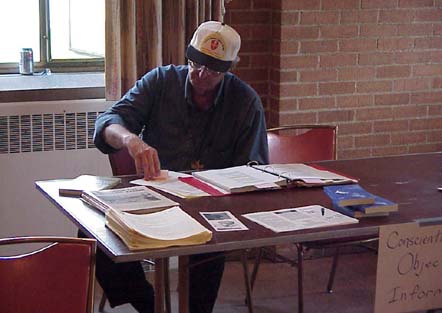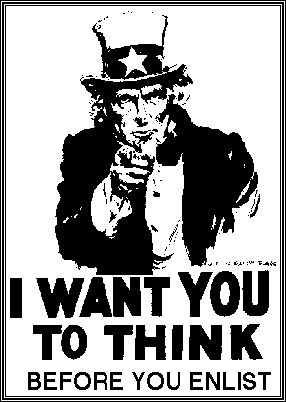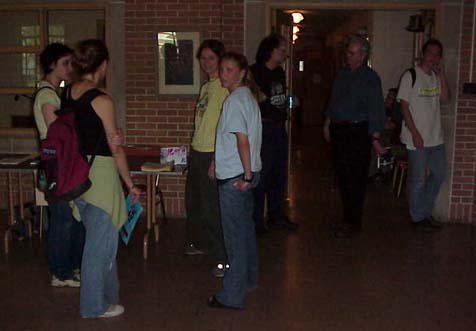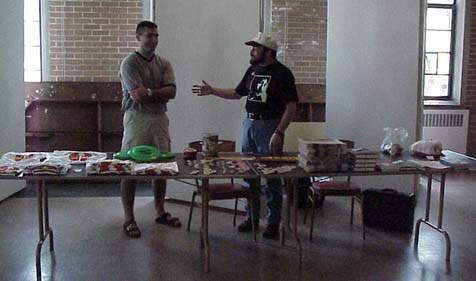 |
Youth, Militarism And Alternatives: A Strategy For Youth OrganizingBy Barry Romo & Dave CurryOur goal is to (1) briefly analyze what happens to today's youth when they are faced with the burden or choice of military service and to (2) describe what can effectively serve as an alternative. Analysis of the Military in American Life Youth action organizing that is an alternative to military service must meet the human growth needs of young people and at the same time bring them into a life of organized political practice. In order to describe such youth organizing, we need to look at the role that the military currently plays in the lives of American youth. How do youth view the military? How does the military shape the values of youth who are not in it? Why do they ultimately join the military? Today's Military Research on military service in the post-Vietnam era has emphasized the degree to which service has become increasingly driven by economic considerations, but we believe that other considerations remain as important. The military still offers itself as the central institution in our society that opposes terrorism and defends the nation.  Changing Nature of Military Service In his classic piece of research on combat soldiers in World War II, S.L.A. Marshall discovered that only fifteen percent of soldiers fired their weapons under fire. He proposed that with proper training, the U.S. armed forces could become more effective with respect to firepower and killing potential. Studies of soldiers in Vietnam showed that Marshall's premise had become a reality. Almost 100% of U.S. combat soldiers in Vietnam fired their weapons in conflict. Between the premise and the realization had come a complete metamorphosis of the U.S. combat soldier. Younger, and with less pre-service experience of the world, the U.S. soldier has become a more efficient product of behavioral science. Perhaps most important has been the creation of a "new morality" for the young soldiers, a morality that is more in tune with the demands of modern warfare. (One writer described the Vietnam War as a moral vacuum in a technological blizzard.) The aftermath of service, the Vietnam-era veteran, may not be as successful a product, but the soldier was everything the World War II researchers had wanted. By the end of the Vietnam War, no one wanted to join the armed forces. The general public had ceased to view the military as a viable career alternative and those serving were regarded as "chumps." The Army and Navy especially made major attempts to change their institutional images. The "new" action Army and at least limited uniform changes in all branches of service were the order of the day. Experts openly talked about the economic motivations for military service. Some mourned the plight of the post-Vietnam force as an army of the poor and minorities serving for non-patriotic reasons. ROTC in high schools and colleges experienced declines in enrollment and programs. But again changes occurred. With the coming of the Reagan years, the exciting and patriotic aspects of military service came to be emphasized. In the years that followed, Desert Storm and the Persian Gulf War were orgies of patriotism and jingoism. Updated images of Rambo, Iron Eagle, and G.I. Joe became the male warrior caricatures in American youth culture, and Demi Moore joined the male images as G.I. Jane. In tight job markets and the last years of the cold war, military recruiters had a fairly easy task. This situation was not to continue. The U.S. emerged as the sole superpower. A rejuvenated U.S. economy allowed the demand for workers to surpass the demand for jobs. Military recruiters face new problems. Enlistment is down. The prospect of being at sea or overseas for long periods of time on "peacekeeping" missions have weakened the appeal of military service. Still, hundreds of thousands of young people continue to enlist. Women, minorities, immigrants, and the poorly educated are the primary targets of recruitment efforts  Rites of Passage Young people, males and females, still use military service as a rite of passage to move from childhood to adult status and privilege. Young people still use military service as a method of escaping from what they perceive as oppression - or at best a humdrum existence - within their families. The military has strong cultural resources on its side: movies, television, and even history as it is sometimes marketed in the schools and media. Much of Hitler's success is said to have been due to his ability to appeal to manhood, heroism, and recognition. The new military, especially in its mass media advertisements, serves as a conduit for the same themes. In our society, the military has many sister institutions. One in particular is this country's ubiquitous system of competitive sports. On one hand, organized sports activities teach skills of social interaction and build healthy bodies. On the other hand, sports convey the message that it is right to sacrifice self, personal dignity, and even previously working body parts to the cause of the team as symbolic neighborhood, school, town, family, and even nation. The coach is often the predecessor of the drill instructor. A letterman's jacket is the harbinger of medals, ribbons, and uniforms as instant material recognitions of manhood and physical achievement. Sports, like the modern military, embraces an ideology of action and sacrifice for its own sake. Junior ROTC and its business partner, high school recruitment, work alongside sports programs more explicitly, providing uniforms, medals, and military discipline to their participants. Promises of bartering high school ROTC skills into college ROTC financial support and scholarships also have to be considered. Among non-participants comes a tendency to accept living in a social world where military symbols are ever-present. Inside the family, the communication between father and child has long been a difficult process. Sports have provided one convenient subject for father-child interaction. But war stories are even better. What he did in military service (or at least some of what he did in military service) is an easy thing for a father to talk about to keep a child's attention. This father-child relation centering on military experience varies from family to family. For some, it's a passive social dalliance. For others, it's summers at brutal marine "bull pup" camps. Also to be considered is the simultaneous inheritance of manhood and military service when the maturing child enlists in the same branch of service that spawned those exciting stories of childhood. "My old man was a marine, and now I'm a marine." In today's setting, even young women may crave that piece of their inheritance from their father.
Military enthusiasm must have a tangible "enemy." This enemy is the military's reason to exist. An enemy must be sinister and powerful. Today's enemies are "small fry" made big with their potential to control weapons of mass destruction. "Suitcase" atomic bombs, sarin and other poison gases, anthrax and other biological terrors, and the ever-present possibility of "destabilization" add appeal to the old opinion that "it's better to fight over there than over here!" This amalgamated enemy establishes the United States' need for a military. The military's role in the lives of American youth depends on its special misperception as a major rite of passage and its misperception as the only protection against the terrorist enemy. These two misperceptions may not just prove fatal for individuals - they may prove fatal for us all. We offer here some characteristics that we feel viable youth organizing must have. We do not define the structure of this organizing, for that must come from youth itself.  Youth Organizing Youth organizing must foster a sense of purpose and personhood that goes beyond simple Ramboism but fulfills the desires of young men and women to be people who make a difference. For those who want more than anything to make a mark on their world, high-minded platitudes and the advice of adults "who know what's good for them" are not especially appetizing. What young people want are their own challenges, their own adventures, and the opportunity to discover some truth of their own. What we must provide them is our guidance in creating democratically structured organizations that provide them the maximum opportunity for personal growth and collective experience. What we want them to have is a chance to make their discovery in a way that is different from our own discoveries made as youth in uniform. Resistance to Militarism and Recruitment One way we believe young people can do this is through their own confrontations with repressive institutions. There is no way that youth can mistake such activity as action that might be taken by "wimps" or "sissies." As Gandhi so often said, the people's strength can come from the unnecessary vile and violent reaction of our enemies to just and principled resistance. Fighting for Justice Young people want the world and their country to conform to their ideal of what is right and just. Chances to contribute to making the world conform to the ideals of youth are not part of a distant past; all around there remain struggles worth joining. Opposition to racist mascots for athletic teams, efforts to "take back the night" from rapists and abusers, struggles for racial and gender equality, and working toward the achievement of self-respect and human dignity in the workplace are all avenues of fulfilling action open to today's youth.  Bridges to Other Nations Immediate access to the experiences of people in other places is another way young people can make their own place in the world. Service projects in which youth work side by side with third world peoples provide this sense of learning from one's own experience while gaining a sense of being part of a greater world struggle. Role of Vets The real experience of Vietnam and other era veterans must be used as a resource in this organizing of youth. Our experience must be brought to bear as a weapon against the lies propagated by recruiters and politicians. Only we can speak with the authority that comes from our own knowledge of the realities of military service and war. Many high school and college age youth want to know what a bullet "really does" to a human being. We can tell them that, and we can tell them what being an instrument of destruction (either face-to-face or from a ship or plane) can do to a human conscience. The myths of military service must be smashed against the truth of our reality. This is our strategy for organizing youth. For youth taking part in these kinds of organizing activity, there is real adventure - personal adventure that is personally liberating and democratic in nature. It is the very opposite of the military training experience of "adventure" and "growth" through subjugation to unreasoning discipline for its own sake. For 31 years, VVAW has continuously carried on a program of outreach to youth.
|

